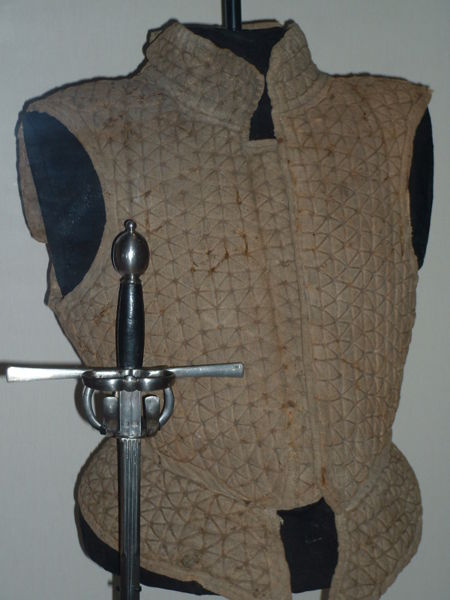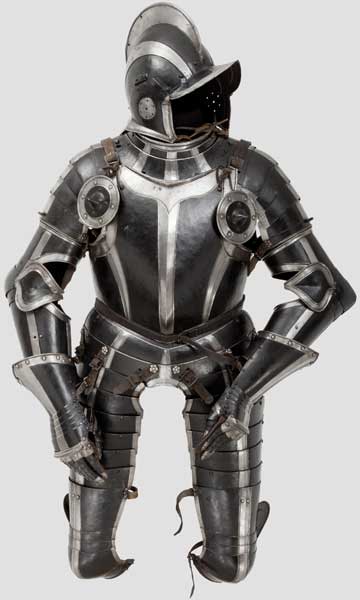| Author |
Message |
Allen Johnson

|
 Posted: Fri 10 Oct, 2014 12:15 pm Post subject: 16th Century Arming Coat/Jack/Gambeson Posted: Fri 10 Oct, 2014 12:15 pm Post subject: 16th Century Arming Coat/Jack/Gambeson |
 |
|
Been trying to find some documentation on late 16th century arming jacks/coats/gambesons... what ever you want to call them. Specifically what would be worn under the notable 3/4th armor such as the black and white suit seen below.
I've seen some good examples of padded jacks, doublets and coats that could be worn under the breastplates or worn on their own, but I can't find any examples of coats where there are placements for the pointing of armor. Any leads?
Thanks ya'll!
 Attachment: 49.11 KB Attachment: 49.11 KB

 Attachment: 23.09 KB Attachment: 23.09 KB

|
|
  |
 |
|
Lafayette C Curtis
|
 Posted: Tue 14 Oct, 2014 4:39 am Post subject: Posted: Tue 14 Oct, 2014 4:39 am Post subject: |
 |
|
I'd say there were two factors that made medieval-style arming doublets become less popular in the 16th century. First, normal civilian attire became more padded and structured than ever before, so I suspect many civilian garments could work decently well as arming undergarments without significant modification. At the same time changes in ranching practices made leather cheaper and more available, so we start seeing the extensive use of leather as armour in the form of buff coats (though this doesn't seem to have really taken off until the 17th century).
The second possible cause is that armour components were now tied/pointed to each other rather than to an undergarment; the gorget served as the foundational piece for this kind of attachment, with the arms being linked to it rather than the sleeves of the arming garment underneath. Of course, conventional leg armour in the medieval style still had to be pointed to the undergarment, and I sometimes wonder if this was a significant factor in the move away from medieval-style legs to the extended tassets of three-quarters armour in the 16th and 17th centuries. I once started a topic with a question about this general subject: http://myArmoury.com/talk/viewtopic.php?t=276...ght=points
|
|
  |
 |
|
Mart Shearer
|
 Posted: Tue 14 Oct, 2014 5:32 am Post subject: Posted: Tue 14 Oct, 2014 5:32 am Post subject: |
 |
|
Real Armerķa: Inventario Iluminado, 1554-58

Similar to this Moroni portrait from c. 1560.

ferrum ferro acuitur et homo exacuit faciem amici sui
|
|
  |
 |
|
Jeffrey Faulk
|
 Posted: Tue 14 Oct, 2014 7:02 am Post subject: Posted: Tue 14 Oct, 2014 7:02 am Post subject: |
 |
|
Mart:
Those two pieces paired together, on the right of the middle row-- what in the world are those? I would think they are two pieces (right and left) of some kind of mail undergarment that are lacking a fabric foundation, but the 'neck' pieces seem to be closed?
|
|
  |
 |
|
Dan Rosen
Location: Providence Joined: 21 Jan 2010
Posts: 98
|
 Posted: Tue 14 Oct, 2014 8:45 am Post subject: Posted: Tue 14 Oct, 2014 8:45 am Post subject: |
 |
|
You may be in luck. A new book on just that subject called Doublets of Defense will be coming out in the not-too-distant future from the Tudor Tailor http://www.tudortailor.com/.
The first image you posted is of a jack of plate, armor on its own, and would not work beneath other armor, having multiple layers of canvas, padding, and at least 1000 steel plates sewn into it. There is an extant doublet ca. 1560 believed to have been intended for wearing under armor as it has both padding and eyelets to accept points (laces) at the shoulder seam which is a very common feature for both 15th and 16th century arming doublets. The problem being that there became a fashion to give a military slant to your civilian dress and adapt details which were lifted from military garments amongst upper crust men and that the extant one doesn't show any sign of wear. That said, we have many, many, many images of arming garments from the period. I have some here on my olllllllllllllld and desperately-in-need-of-updates website including the extant one [url]http://strangeandfarre.weebly.com/arming-garments.html [/url] Towards the end of the century, you also start to see leather jerkins coming into more significant use for padding under armor as well to a large degree mirroring civilian fashion. There will be many more images beyond these in Doublets of Defense.
If it helps, I recently made a hypothetical arming doublet based on the extant one and several images and it worked very well. More info and pictures here... [url] https://www.facebook.com/media/set/?set=a.890957567597342.1073741836.697208360305598&type=3 [/url]
Hope this helps!
-Dan Rosen
"One day there will be no more frontier, and men like you will go too."
|
|
  |
 |
|
|

